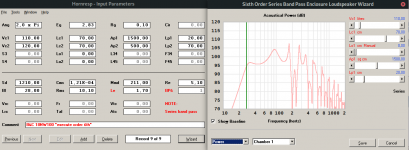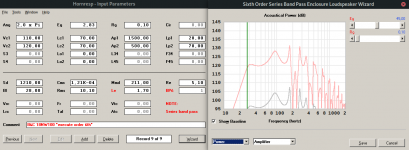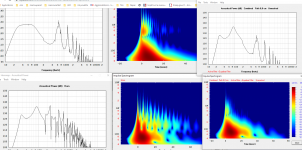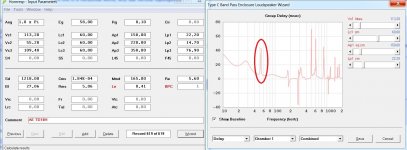
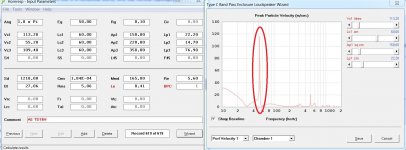
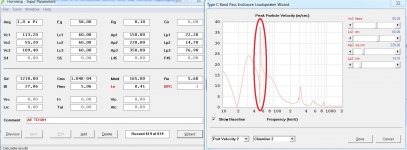
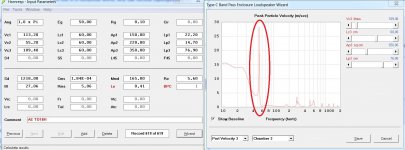
I really don´t like to criticize other peoples designs and there are already too much of nitpicking criticism in this forum, but your design makes me a little perplexed.
You call this "somewhat cleaner and smoother" yet you have a large high Q group delay peak in the middle of the passband and the internal port velocities have huge peaks in the middle of the passband.
I guess you have some kind of though behind this. I am all for improvements and I want to encourage people to better my designs. I am just a happy amateur with Hornresp on my computer and 50+ basshorn/tapped horn/bandpass builds behind me so I am sure most of my design can be improved upon in many ways.
But in this case I don´t understand what you are trying to achieve?!?
The spl curve of my 6th order series tuned BP is not an accident. I made it that way as it makes for a great sounding BP. I prefer a somewhat accentuated midbass peak bring some needed "life and vividness" back to the sound character to compensate for the with falling frequency increasing room gain profile of most listening rooms. Many simulated "flat" designs tend to sound to bottom heavy in a normal indoor listening environment, and 6h order BPs tend to exaggerate this "bottom heavy - lacking punch and drive" character even more. Add a large 18 inch driver into the mix and the 6th order BP playing bass indoors is almost guaranteed to sound overwhelmingly heavy and lacking punch and attack without these tricks.
Large internal ports that keeps air velocity low combined with a huge exit port that couples well to the listening space, a touch of positive acoustic and mechanic feedback and a somewhat accentuated midbass peak makes for a fun BP that sounds punchy with a great attack in my experience.
Regards,
Johannes
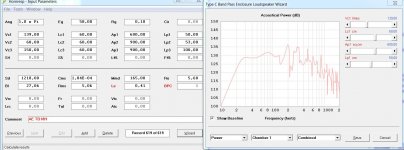
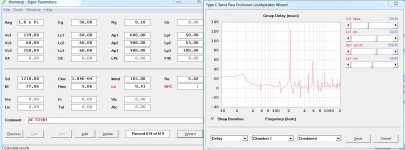
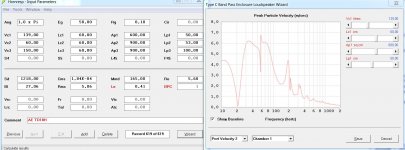
I tried to make a BPC more to my liking. This is my preferences and my ideas and not automatically better.
I don´t like the jagged kinks in the phase, GD and port velocity graphs. They indicates a messy mix of different responses trying to cooperate but not really having the ability to do that in a orderly and smooth way.
This problem will be exacerbated with increasing port velocities, nonlinear waveforms and hard real life use, and I have a parallel tuned 8th order BP that have a small kink in the GD and phase graph in the middle of the passband. It does sound really nice if crossed over below that kink, but it sounds horrible whenever allowed to play music around that frequency.
You got your way to do your stuffs, but generally it is expected a speaker to be neutral, and for a subwoofer, primary to make a nice integration with higher way (midwoofer)  .
.
Since you advised this design on a public thread, you should have been prepared to discuss pro/cons . I have no problem with critizing, or getting criticized. Those are just design ideas. No incidence on anything important
. I have no problem with critizing, or getting criticized. Those are just design ideas. No incidence on anything important 
I showed the impulse spectrogram to allow anyone to get a idea of the ripple this kind of design involve. It share similitudes with tapped horn, if it isn't just a variation, if we really need to give a name to everything... But good way to damp a classic tapped horn to tame ripple have been experimented and still are hard to deal with (between S1-S2, and just after S2). That is why i showed the spectrogram : how to deal with such ripple ? I have no clue.
Why to add a "midbass peak" (at 90hz ?...) on a 25-90hz subwoofer. It make it somewhat impossible to crossover with mid-woofer way. Or it is a way to volontary add H2 distortion around 45hz ? This could be a really interesting effect, but it can be explained as simply as it, and that can explain your feelings. If one want to add nice H2 harmonics on subrange, there's others ways, and electronic ones that can be switched on/off.
Yes, i did a 10 minutes weird design sim, just to play with hornresp 😉. The reaaaally high Q peak comes from a funny tuning compensation tweak found unvoluntary between reflex chambers. I like this arrangement, and it work like a charm in this case. Easy to tune with simple plumber pipes, and very little stuffing in last chamber, this artifact can be nulled, it is easy to see playing with sliders in hornresp.
It is a design that allow build margin with 3 pipe that can be tuned (slot cannot be tuned easily), and need really little stuffing if not a all to be clean. Since we're discussing in this thread about bandpass boxes, it was only to show what bandpass out of band rejection can be expected with same size/spl, even at lower order (so lower group delay once substracted time delay involved). But of course, real bandpass involve low level of harmonic, and so lower effect.
There's no better, or worst. It is all matter of compromise. But it is wise to know what are the compromise.
 And so it was BP9 before because 3 character limited, but in fact it is FBDBRC, wich was too hard to pronounce (Front Bandpass Dual Back Reflex Chambers)
And so it was BP9 before because 3 character limited, but in fact it is FBDBRC, wich was too hard to pronounce (Front Bandpass Dual Back Reflex Chambers)
 .
. Since you advised this design on a public thread, you should have been prepared to discuss pro/cons
 . I have no problem with critizing, or getting criticized. Those are just design ideas. No incidence on anything important
. I have no problem with critizing, or getting criticized. Those are just design ideas. No incidence on anything important 
I showed the impulse spectrogram to allow anyone to get a idea of the ripple this kind of design involve. It share similitudes with tapped horn, if it isn't just a variation, if we really need to give a name to everything... But good way to damp a classic tapped horn to tame ripple have been experimented and still are hard to deal with (between S1-S2, and just after S2). That is why i showed the spectrogram : how to deal with such ripple ? I have no clue.
Why to add a "midbass peak" (at 90hz ?...) on a 25-90hz subwoofer. It make it somewhat impossible to crossover with mid-woofer way. Or it is a way to volontary add H2 distortion around 45hz ? This could be a really interesting effect, but it can be explained as simply as it, and that can explain your feelings. If one want to add nice H2 harmonics on subrange, there's others ways, and electronic ones that can be switched on/off.
Yes, i did a 10 minutes weird design sim, just to play with hornresp 😉. The reaaaally high Q peak comes from a funny tuning compensation tweak found unvoluntary between reflex chambers. I like this arrangement, and it work like a charm in this case. Easy to tune with simple plumber pipes, and very little stuffing in last chamber, this artifact can be nulled, it is easy to see playing with sliders in hornresp.
It is a design that allow build margin with 3 pipe that can be tuned (slot cannot be tuned easily), and need really little stuffing if not a all to be clean. Since we're discussing in this thread about bandpass boxes, it was only to show what bandpass out of band rejection can be expected with same size/spl, even at lower order (so lower group delay once substracted time delay involved). But of course, real bandpass involve low level of harmonic, and so lower effect.
There's no better, or worst. It is all matter of compromise. But it is wise to know what are the compromise.
In case anyone else was wondering what a "BPC" is : Hornresp
 And so it was BP9 before because 3 character limited, but in fact it is FBDBRC, wich was too hard to pronounce (Front Bandpass Dual Back Reflex Chambers)
And so it was BP9 before because 3 character limited, but in fact it is FBDBRC, wich was too hard to pronounce (Front Bandpass Dual Back Reflex Chambers)
Last edited:
View attachment 792157
View attachment 792158
View attachment 792159
I don´t like the jagged kinks in the phase, GD and port velocity graphs. They indicates a messy mix of different responses trying to cooperate but not really having the ability to do that in a orderly and smooth way.
...Try eq it flat with hornresp filters, and see the magic happens

About the peak, i already answered. In your design
 , the different path, as shown in spectrogram, don't even try to cooperate
, the different path, as shown in spectrogram, don't even try to cooperate  if i use your words
if i use your wordsCome on, do you try to convince us that you have not any in room null and resonnance so that this become a bigger problem ? Or maybe you live in a mattress shop, but i become sarcastic, sorry, it is just that i feel you try to defend yourself as if you were attacked, while it is not at all the case. We're totally autorized to disagree, without need to mix everything to prove a point. And still, i agree, there's a peak on the sim "something that try to cooperate". This would be worrying, but it can be tuned to disapear, to make stuff "cooperating"/nulled.I have a parallel tuned 8th order BP that have a small kink in the GD and phase graph in the middle of the passband. It does sound really nice if crossed over below that kink, but it sounds horrible whenever allowed to play music around that frequency.
Last edited:
Large 18 inch driver into the mix and the 6th order BP playing bass indoors is almost guaranteed to sound overwhelmingly heavy and lacking punch and attack without these tricks.
Agree.
Thanks for explanation, Johannes.
Agree.
Thanks for explanation, Johannes.
"Order" only define slope. The higher order, the slopper the slope, the more the group delay increase. In fact, higher order for sub is generally a compromise to get more efficiency, in exchange of size/bandwith/group delay.Large 18 inch driver into the mix and the 6th order BP playing bass indoors is almost guaranteed to sound overwhelmingly heavy and lacking punch and attack without these tricks.
Agree.
Thanks for explanation, Johannes.
There's different typologies to do a 6th order, and each can be tuned to do a frequency response really smooth, or curved as Johannes likes, ripple full, or ripple less, with more/less bandpass effects...all kind of compromises can be done.
Why do you want your sub to add a "midbass" bump, can't it be done Equing midbass way instead ?
What is your crossover plan without correcting this frequency bump ?
What about the ripple in bandpass ?
😕
Last edited:
Just to show that it is all about EQ, it EQed my ugly sim, to the same response <150hz as Johannes sim. I did it with 1 high pass, 5 peak eq.
Picture 1 show before/after Equing the Front Loaded Dual Bass Reflex Chamber (FLDBRC) as Jonannes 6th (on the left).
Picture 2 is somewhat...hard...
Column 1, response of FLDBRC and Jonannes's 6th without EQ.
Column 2 their spectrogram.
Column 3, EQued FLDBRC <150hz as Jonannes's 6th, and it spectrogram.
So, EQuing => same result < 150 hz (the two spectrogram downward)....=> this mean same group delay of course.
(the two spectrogram downward)....=> this mean same group delay of course.
>150 hz, the FLDBRC got more bandpass effect that reduce distortion.
This is all about EQuing...
About the "huge exit port that couples well to the listening space" that is non-sense, this is pressure variation at those frequencies. Room should be considered as part of the enclosure. From there, about "touch of positive acoustic and mechanic feedback" , the two "outputs" of the FLDBRC, or other 2 output design, can be blended as well in room.
Picture 1 show before/after Equing the Front Loaded Dual Bass Reflex Chamber (FLDBRC) as Jonannes 6th (on the left).
Picture 2 is somewhat...hard...
Column 1, response of FLDBRC and Jonannes's 6th without EQ.
Column 2 their spectrogram.
Column 3, EQued FLDBRC <150hz as Jonannes's 6th, and it spectrogram.
So, EQuing => same result < 150 hz
 (the two spectrogram downward)....=> this mean same group delay of course.
(the two spectrogram downward)....=> this mean same group delay of course.>150 hz, the FLDBRC got more bandpass effect that reduce distortion.
This is all about EQuing...
About the "huge exit port that couples well to the listening space" that is non-sense, this is pressure variation at those frequencies. Room should be considered as part of the enclosure. From there, about "touch of positive acoustic and mechanic feedback" , the two "outputs" of the FLDBRC, or other 2 output design, can be blended as well in room.
Attachments
Last edited:
Interesting...
I think that the a little bump around high cutoff frequencies make it easier to integrate with midbass.
By the way... What you guys think about midbass solution for those enclosures and woofer - 90-300hz? It could be anything from 2-4 - 8", 2x10", 2x 12" or one 15".
Lately I have build lots of cabinets including: 4 x 6.5" - don't like small drivers in midbass, 2 x B&C 10CL51 seal and ported - cheap sound, 2 x 12" Faital Pro 12PR300 in basshorns, BR and Paraflex kick - better but still economy drivers, JBL 2262HPL in Paraflex, BR and Basshorn - not bad, RCF L10/750YK - very good, but not sure it can handle 95Hz, Altec 416 - beautiful tone and realistic sound but no kick etc. IMHO.
I still have those drivers +8 8" JBLs midbass and still looking for the midbass for home use.
I can buy used JBLs or new RCF or other 12-15" drivers if they provide better result.
I think that the a little bump around high cutoff frequencies make it easier to integrate with midbass.
By the way... What you guys think about midbass solution for those enclosures and woofer - 90-300hz? It could be anything from 2-4 - 8", 2x10", 2x 12" or one 15".
Lately I have build lots of cabinets including: 4 x 6.5" - don't like small drivers in midbass, 2 x B&C 10CL51 seal and ported - cheap sound, 2 x 12" Faital Pro 12PR300 in basshorns, BR and Paraflex kick - better but still economy drivers, JBL 2262HPL in Paraflex, BR and Basshorn - not bad, RCF L10/750YK - very good, but not sure it can handle 95Hz, Altec 416 - beautiful tone and realistic sound but no kick etc. IMHO.
I still have those drivers +8 8" JBLs midbass and still looking for the midbass for home use.
I can buy used JBLs or new RCF or other 12-15" drivers if they provide better result.
The easiest way to integrate different ways is to try to get close to textbook crossover slope, and so, no bump a all, because any bump (except when playing with FIR, filler driver...etc) will cause phase shift. And so will affect crossover bandwith ways integration. But there's a lot of ways to make two ways integrate well, even with bump that should be partially nulled with some phase shifting of the other way. I really encourage you to sim crossover with real measurement datas...And you have to consider time delay of higher ways for alignement needed with those high order subwoofers (around 4-6 ms for the two design shown). Crossover is probably as important as enclosure design.
Try eq it flat with hornresp filters, and see the magic happens
I could not agree more.
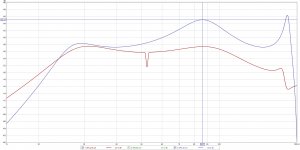
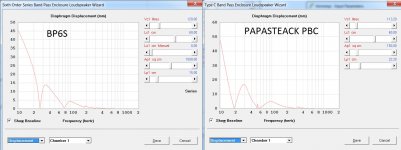
My 6th order BP is up to 7,3 dB more efficient at the very important mid bass centered around 80 Hz then your BPC.
I prefer to EQ away 7,3 dB in the mid bass where most of the energy is centered in modern music. All that power is better used where it is needed more (for example in the low end of the passband).
7,3 dB more output from roughly the same cone displacement in the mid bass translates into less distortion, less inter-modulation distortion and a subjective better sound quality. Once again considering that the energy content is centered around 80 Hz in modern music, then a 7,3 dB reduction of power will keep the voice coils much cooler or you can play a lot louder with the same level of thermal compression.
I have intentionally disregarded the 115 m/s peak in the port velocity graph, but I suspect that it will not add any positive contribution to the perceived sound quality of your design.
I think that the a little bump around high cutoff frequencies make it easier to integrate with midbass.
This is my experience to.
See all the old FLHs of the good old days. Turbosound, JBL, Klangfilm, WE, Klipsch etc.... Great mid bass punch.
A good mid bass punch from the subs takes a lot of strain of the top system, lowering the distortion of the typical 12 or 15 inch midbass/midrange driver and makes it much easier to integrate.
I was talking about phase/group delay.I could not agree more.
Of course, you got lower displacement, high pass slope (order) is not at all the same. I pretty agree. And don't forget that i do not say my design is better. I just used it as example of bandpass rejection effect, and i should add, better damped response.
About the bump, I can admit this is can be a good idea on paper, if suitable crossover is doable. But as show in post #50, it gives lagging response at the concerned frequency, a typical underdamped response.
About the peak at 115m/s, it's a kind of artefact on 1-2hz large bandwith. It can need tuning if one want to build something like this. And we cannot add damping in hornresp in bandpass wizard to damp the sim. This design is just a crash test to question yours about compromises dones.
I was talking about phase/group delay.
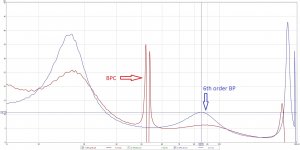
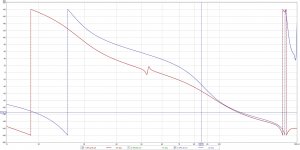
Sharp high Q kinks in the phase and GD response is often more detrimental to SQ then soft low Q peaks (in my experience).
I know you can flatten these curves in Hornresp with careful adjustment of the port lengths. But in real life where port compression and turbulence changes the tuning in a nonlinear amplitude dependent manner this problems will be very audible.
Forget about my stupid sim. I was just trying to figure why you choosed this kind of response, while you know well how to play hornresp. You've answered. No offense. The biggest point of you design is it folding. If it work as it sim, it's really interesting. Personally I prefer having tweaking margin for building with port and lower order but this is just my own preference of compromises. I'll build a 35-150hz sub with the shown topology, but this is probably not before next summer. We should see how it turns about this peak that worry you so much. Nulling and damping is exactly what TL design are about. This works fine. And port compression/turbulence s can be really well limited with curved input/output. In fact hornresp yet suppose one of the two port is somewhat flared (I expect David not to come to say I didn't understand ! ^^). In hornresp this "End correction" explain the variation of a enclosure simed with bandpass wizard compared to when simed as multi segment design.
Last edited:
I'll build a 35-150hz sub with the shown topology, but this is probably not before next summer
Interesting! 🙂 I am sorry to read the "next summer" part though. I love builds that are more thought through and more elaborate then normal standard run of the mill bass reflex or closed box. I am looking forward to your build and I hope it turns out well!
port compression/turbulence s can be really well limited with curved input/output
True! I have had a lot of success with rounding every edge with a large radius router in my tapped pipe and tapped horn builds. The air velocity and the sheer amount of air being moved is quite impressive when you try to hit 145 dB @ 33 Hz in a car with a single 10 inch driver.
Regards,
Johannes
I ordered this 12NSW600 and actually waiting since 2 month only for processing delay.Interesting! 🙂 I am sorry to read the "next summer" part though.
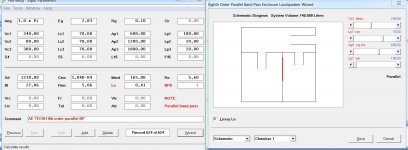
This is the reason I would not recommend the AE TD18H in an 8th order BP.
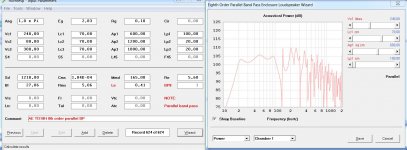
Even though this might be quite fun once built!!!
This is not optimized in any way. It is a fast and not thought through example of what range of enclosure sizes we are talking about.
If built out of 36 mm birch plywood with lots of bracing (to keep the huge panels reasonably stiff) then I guess we are looking at something quite close to a cubic meter. 😀
A very fun and capable home theater sub if someone has the space and love buying birch plywood in bulk.
- Home
- Loudspeakers
- Subwoofers
- An adventure with 8th order BP
